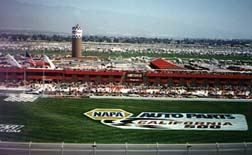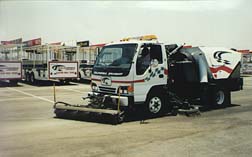Profiles in Parking Area Sweeping |

Raceway Sweepers Must Really Performby Kathy SheehanSpeeding down a straight-away at 150 mph, and accelerating around curves, a professional race car driver must possess nerves of steel. To win the race - or just finish alive and without injury - s/he relies on a mechanically sound car, a speedy pit team and a clean, dry race track. Hazards such as a patch of oil from a wrecked car ahead or a three-inch bolt from a severed oil pan can create a deadly spinout or a last-place finish with a flat tire. That's why race track managers do everything they can to eliminate any factor which could affect a safe, level playing field for the drivers. At Maple Grove Raceway, a quarter mile race facility in Mohnton, PA, race course maintenance is John Krupiak's responsibility. And he has to be quick about it. The fans wait anxiously for the race to continue after a car has spilled its guts onto the race course, and the racers are literally revving to go again. Idled engines can overheat during even the smallest delay, and in quarter mile racing, their performance will also change significantly if forced to cool down. "Even the mentality of the racers is on the line," Krupiak says. "They get into a 'zone' and they're prepared to go race. Things like 'down time' throw them off. It can definitely affect the outcome of the race. Oil is a particularly slippery problem for the 70 to 80 events held each year at Maple Grove. We're not afforded the time to do extensive cleanups. Our objective is to get the oil off, put a safe track underneath the racer and get right back to racing." 
Pressure washing takes too much time. So, Krupiak's crew employs a multi-step, efficient, process using absorbent ash from hulled rice. They pick it up with a 3-yard parking lot-designed air sweeper. Krupiak says a burned rice hulls byproduct is the best absorbing agent for removing oil and other engine fluids from the race course. The ash leaves a white residue, though, and must be removed to maintain the track's clean appearance. If any ash remains after cleanup, Krupiak says, the racers "feel as though there is still something underneath that will cost them traction. Everything needs to be very precise." Krupiak wants the cleanup operation to be as quick as possible, too, since the down time alone can affect a race outcome. "The fans want to maximize their time watching the racers, not the cleanup crew. They came to see racing, not watch a sweeper, although it is pretty amazing how they'll do that, too. Race fans are so afraid they might miss something that they'll sit there and watch the entire cleanup operation. It's an exciting sport, and nobody wants to miss a run." Krupiak's crew uses a heavy-duty, construction-type broom mounted onto a tractor. The broom beats the oil-soaked ash to facilitate pick-up, then the sweeper is run over it. Ed Straub, Jr., is director of operations and facilities for the California Speedway in Fontana, CA, America's newest NASCAR racetrack. The requirements for sweeper use are somewhat different there, where the extreme slant of the oval track makes it impractical to clean with a sweeper. The track itself is blown clean with a towed jet engine, and then tires are dragged along the pavement to re-deposit a layer of tire rubber onto the track surface. Straub agrees that their pavement's appearance is an important component of running a successful raceway, however. "You only get one chance to make a good impression," he says, "and part of the Penske philosophy is to make a great impression every time." 
California Speedway, a 529-acre facility, owns two 3-yard parking area sweepers that it uses for its extensive infields, for its road courses, and on its whopping 32,000-car parking area. "They're especially useful when a sudden downpour leaves us with a 'bird bath' on the track. They make it easy and quick to just go out and suck the water up. With these sweepers, we end up with the surface almost dry," Straub says. "We also use them to remove water originating from our sprinkler system when we need to use our road course. We have a number of car makers, including Lexis, Pontiac and Chevrolet, who use our facilities to debut new car models and, at the introduction of the new model year, they invite riders and drivers here to try out and test their vehicles. As you can imagine, we need to have a sparkling clean facility for these projects, and our sweepers play a big part in that. We also use them on a daily basis to clean our streets on the property," Straub adds. "The hose attachments are very handy for getting into the corners, as well as for cleaning out the drainage channel on the south side of the park. "We also have to deal with the Santa Ana wind. When it kicks up, it blows dirt in from the desert, east of us. It will create these huge dust clouds which then settle down onto the track. When the track has a lot of contaminants or particles on it, it'll chew up the tires faster. We had this problem when we ran the IROD cars. They were going through tires every 20-25 laps. The tires are real soft; they're not like highway tires. "[At first] we were going to try to wash the track, but we discovered that ends up washing the rubber off, and you don't want that to happen. And with asphalt, you've got all those little crevices where the dirt can hide. By using air sweepers, we can get all that dirt up. We have to deal with the EPA, so keeping the dust down is a big issue with us, too." The usage of sweepers at racetracks as divergent as the flat strip Maple Grove and the steep-banked oval California Speedway show how important sweeping is for any pavement-based area. Sweeping contractors all know the value of sweeping, however most of the population take for granted the job that sweepers do. When you talk to people who operate high profile pavement-based facilities like the two racetracks in this article, the importance of timely, efficient, quality sweeping becomes clear. Kathy Sheehan is a free-lance journalist and editor of prweb.com. You can write to her at kathy@sheehanworld.com. This article is reprinted from American Sweeper magazine, Volume 6 Number 2. |
© 2005 - 2012
|
Parking Area Sweeping Contents
|